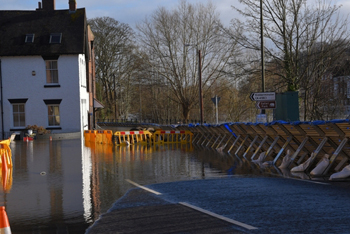Local authorities must do more to prepare for flash flooding as official figures reveal tens of thousands of homes are built in at-risk areas.
A new report published today by think tank Localis argues that the connection between increased urbanisation and surface water risk demands greater co-ordination between the public sector, developers and wider society.
The study – entitled Surface Tensions – working together against flash flooding – found that responsibilities for managing flood risk are fragmented between central government departments, agencies and local bodies, resulting in confusion in the event of a flood.
The report also warned that minor developments comprising nine houses or fewer, infill or permitted development are aggregating the risk of surface flooding across an area, without a legal requirement to provide sustainable drainage.

Bewdley, Worcestershir, February 2022
Official figures cited by Localis for the year to June 2022 show that 35,000 dwellings where more than 1% of homes are already at risk of flooding received planning decisions from councils as part of minor developments. Given that 73% of minor development applications were approved across England in the same period, this could mean as many as 25,550 new homes built in areas that are already at risk of flash flooding.
Among the report’s recommendations was the creation of a strategic planning authority with power for national and local risk management authorities, such as the Environment Agency and Lead Local Flood Authorities (LLFAs), to work closely together.
The report also called for stronger collaboration between developers, landowners, LLFAs and central government agencies to understand and manage flood risk and resilience, and for this to be encouraged and incentivised across all new developments.
Localis visiting fellow Professor Samer Bagaeen said: ‘To tackle surface flooding, the next revision of the National Planning Policy Framework must require Local Plans to demonstrate how lead local flood authorities have assessed aggregate risk across the whole area, as well as how flood impacts will avoided, controlled, mitigated, and managed.
‘And at the level of place, for infrastructure and procurements concerning flooding, lead local flood authorities should move away from human-engineered barriers and toward natural drainage systems that work to slow the flow of surface water and relieve pressure on sewers.’
Localis head of research Joe Fyans said: ‘As the UK is experiencing extremely wet days – more days of heavy summer rainfall on impermeable ground as well as a significant increase in heavy winter rainfalls – we are seeing an unsurprising increase the incidence of surface water flooding.
‘How we go about funding this will be crucial. Central government would be best advised to pproduce a comprehensive flood infrastructure funding programme that is less restrictive and targeted toward places most at risk, while also encouraging bottom-up practice by streamlining the funding process for smaller, district or community-based projects.’
This article first appeared on localgov.co.uk
.
Register now for full access
Register just once to get unrestricted, real-time coverage of the issues and challenges facing UK transport and highways engineers.
Full website content includes the latest news, exclusive commentary from leading industry figures and detailed topical analysis of the highways, transportation, environment and place-shaping sectors.
Use the link below to register your details for full, free access.
Already a registered? Login